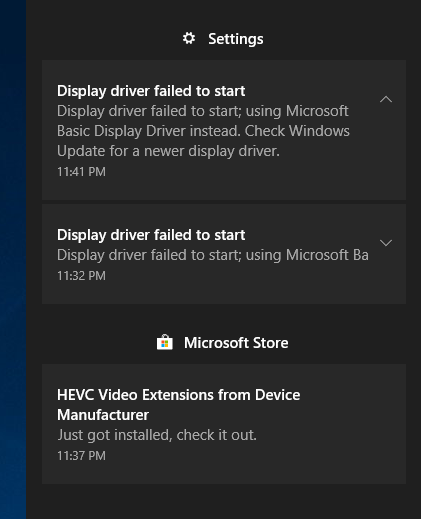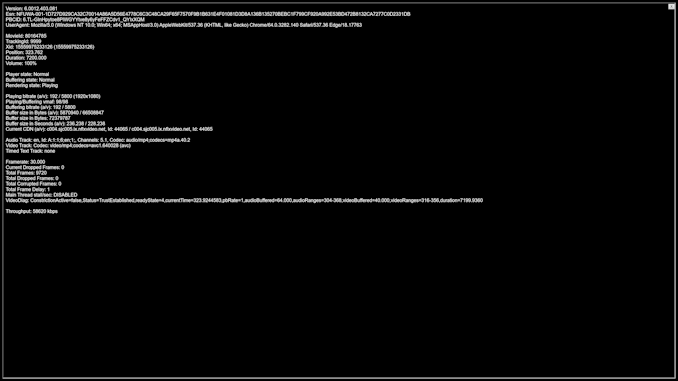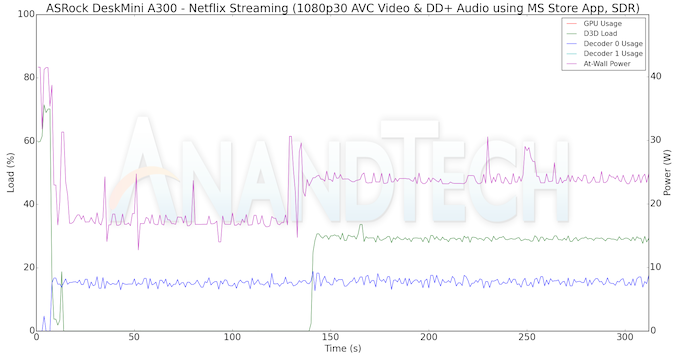The ASRock DeskMini A300 Review: An Affordable DIY AMD Ryzen mini-PC
by Ganesh T S on April 26, 2019 8:00 AM ESTHTPC Credentials - YouTube and Netflix Streaming
Streaming of 4K OTT content with YouTube and Netflix has become mainstream. HDR displays have also started becoming affordable. In order to evaluate YouTube HDR streaming support, we have the Mystery Box's Peru 8K HDR 60FPS video as our test sample. On PCs running Windows, it is recommended that HDR streaming videos be viewed using the Microsoft Edge browser after putting the desktop in HDR mode.
HDR content on YouTube is encoded exclusively in VP9 Profile 2. On systems supporting hardware accelerated decoding of VP9 Profile 2, Edge streams and decodes the HDR stream. The DeskMini A300 passes this test, and we can see HDR YouTube videos, as shown in the picture above.
Various metrics of interest such as GPU usage and at-wall power consumption were recorded for the first four minutes of the playback of the above video. The numbers are graphed below.
Decoding 4Kp60 VP9 Profile 2 videos consumes between 70 and 90% of one of the decoder engines. We also see some Direct3D loading of the order of 70% initially (when the stream being played back is at a lower resolution and needs to be upscaled to 4K). Once the stream stabilizes and the system starts decoding the 4K stream, the Direct3D loading settles around 50%. The average at-wall power consumption for streaming 4K YouTube HDR videos is around 33W.
4K HDR streaming in Netflix requires support for hardware-accelerated decoding of HEVC Main 10 videos. Microsoft removed the in-built HEVC decoding capabilities of Windows 10 in the 2017 Fall Creators Update, and replaced it with an extension that had to be downloaded from the Microsoft Store. Without the extension, playback is restricted to 1080p non-HDR streams encoded in H.264. In addition to the decoding capabilities, the system also needs to support PlayReady 3.0 DRM. In our tests with the Radeon 19.4.2 driver release, we ran into major problems.
Our usual testing flow involves the installation of the HEVC Video Extensions and the Netflix apps from the Microsoft Store. After configuring the Netflix login credentials, we attempt to play back Season 4 Episode 4 of the Netflix Test Patterns title. Unfortunately, the DeskMini A300 behaves in an unexpected manner when subject to the above steps. As soon as the playback of the title starts, the screen goes blank and the display driver crashes.
Windows reverts to the basic display driver, and the Netflix title continues to play back. However, instead of the expected 4Kp60 HEVC Main 10 stream (with HDR), we only get a 1080p30 AVC stream. In order to prevent the crashing of the driver in the course of our evaluation, we opted to uninstall the HEVC Video Extensions app, and make use of only the AVC decoder built into Windows. Without the HEVC Video Extensions, the driver has no problem with standard 1080p Netflix streaming. The OS screenshot facilities obviously can't capture the video being played back. However, the debug OSD (reachable by Ctrl-Alt-Shift-D) can be recorded.
The (avc) entry corresponding to the Video Track in the debug OSD, the Framerate (30.000), and with the A/V bitrate details (192 kbps / 5800 kbps) indicate that we are only getting a low quality 1080p stream compared to the best available one (4Kp60 16 Mbps HEVC Main 10 HDR stream). Similar to the YouTube streaming case, metrics such as GPU usage and at-wall power consumption were recorded for the first three minutes of the playback of the title. The numbers are graphed below.
1080p30 AVC playback is a walk in the park for modern computing systems. We see that the Direct3D loading is only around 30% and the decoder usage is less than 20% in the steady state. The former is mainly due The at-wall power consumption is around 24W for this workload.















88 Comments
View All Comments
Irata - Thursday, May 2, 2019 - link
True about the system. Memory was good, but the SSD was a slower one.Basically, I would really like to see premium components being used in AMD based systems just like in Intel systems (or you could do it the other way around to reach the same price).
mikato - Thursday, May 2, 2019 - link
My price comparison cancelled out the reviewer's choices of memory and SSD. Those are things each person can choose.suraj jha - Wednesday, May 1, 2019 - link
Quickbooks online support is the best smarter business tools which resolves any issues in business accounting software. Here you may benefited by phone or post queries. https://www.quickbookspayrollonline.com/duartix - Thursday, May 2, 2019 - link
I've searched the whole article for the word "Noise" and I couldn't find a single reference. :(On a HTPC perspective, noise can be a determining factor.
How will it stack up when compared to Intel NUCs?
sor - Thursday, May 2, 2019 - link
It’s very quiet while gaming, at least if you use the wraith cooler. Much quieter than any video card (aside from fabless ones of course. Not completely inaudible but quieter than my MacBook Pro.mikato - Friday, May 3, 2019 - link
Thank you! Now that is a good comparison. I'm guessing it's quiet enough for me and my 6 foot HTPC situation. How about when not gaming? Is playing Youtube or Netflix or something basically not noticeable at all?alicetaylor - Monday, May 13, 2019 - link
great article, I was very impressed about it, wish you would have stayed next sharehttp://mutilateadoll2game.com
Dik - Sunday, July 14, 2019 - link
Will the ASRock A300 be coming out with USB 3.1 Gen 2? Can this be a BIOS upgrade? or it a feature of the chipset? I assume you can use the Rizen 3900X processor.Dik